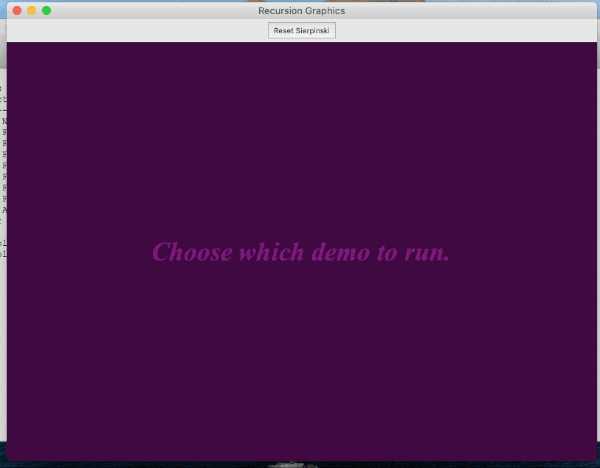Assign3: Sierpinski
Recursion can create incredible graphic designs of images that have self-similar subparts (also known as fractals). One of the most famous fractals is the Sierpinski triangle, named after the Polish mathematician Waclaw Sierpinski (1882–1969).
As with many self-similar images and fractal patterns, it is defined recursively:
- An order-0 Sierpinski triangle is a plain filled triangle.
- An order-n Sierpinski triangle, where n > 0, consists of three Sierpinski triangles of order n – 1, whose side lengths are half the size of the original side lengths, arranged so that they meet corner-to-corner.
For example, here are Sierpinski triangles of the first few orders:

Take a moment to confirm that the order-1 Sierpinski triangle indeed consists of three smaller copies of the order-0 Sierpinski triangle, that the order-2 Sierpinski triangle is formed from three smaller copies of the order-1 Sierpinski triangle, and so on.
As a note, although it might look like we’re drawing a single black triangle with a lot of white triangles inside it, that’s actually not the case. Every triangle drawn here is black; the white triangles represent places where no triangle was drawn. Thus, your code should only draw the black triangles that make up the Sierpinski triangle. The white parts of the triangle are, in a sense, “negative space”, or regions where nothing is drawn.
Your task is to implement the function
void drawSierpinskiTriangle(GWindow& window, GPoint one, GPoint two, GPoint three, int order)
that takes as input the three corner points of a triangle and the order. The function draws a Sierpinski triangle defined by those three corner points and of the specified order into the given window.
We provide the fillBlackTriangle helper function to fill a triangle defined by its three corner points:
void fillBlackTriangle(GWindow& window, GPoint one, GPoint two, GPoint three)
Important information
- Error handling: Your code should not crash (stack overflow) when provided with erroneous (negative) inputs. Thus, as in the factorial warmup, you should throw an error if the provided order is negative.
- Draw pictures! One key part is figuring out where each triangle’s corners are, and that’s easier to do with a diagram in front of you.
- The midpoint of each side of the large outer triangle becomes a corner of one of the smaller inner triangles. Given a line segment whose endpoints are
{x1, y1}and{x2, y2}, its midpoint is at{ (x1+x2)/2, (y1+y2)/2 }. - We will be working with the GPoint class when solving this problem. We highly recommend reading through the linked documentation, in addition to checking out the slides from Tuesday's lecture on the topic.
- The three corner points of the triangle don’t necessarily have to form an equilateral triangle or be parallel to the base or side of the window. There isn’t any particular ordering to which corner is identified as
oneversustwoversusthree. - The only function you should call to draw things in the window is
fillBlackTriangle, mentioned above. You do not need to dig into any other drawing functionality in the Stanford libraries.
Testing graphics
A function that produces graphical output, such as Sierpinski, doesn't lend itself to being unit-tested, so we've provided a simple GUI you can use to interactively test your drawing code. Our starter code calls a function named runDemos from the single "unit test" at the bottom of the sierpinski.cpp file. You should not modify this provided code. In order to run the graphical demo, all you have to do is pull up the usual main menu of tests, and select the option to tun tests from sierpinski.cpp. Here is a screencast that demonstrates using the graphical program display that comes up when you select this option.

In the GUI, use the slider to change the order and drag the corners to change the triangle dimensions. Visually inspect the drawing for correctness. When are you done testing, simply close the window to exit the GUI.
Q8: Without automated unit tests, you need to develop new techniques for test coverage. What were the strategies you used for testing Sierpinski?
Possible extensions
The Sierpinski triangle is only one of many self-similar images; consider coding up another! We’d love to see what you create.
Some resources: